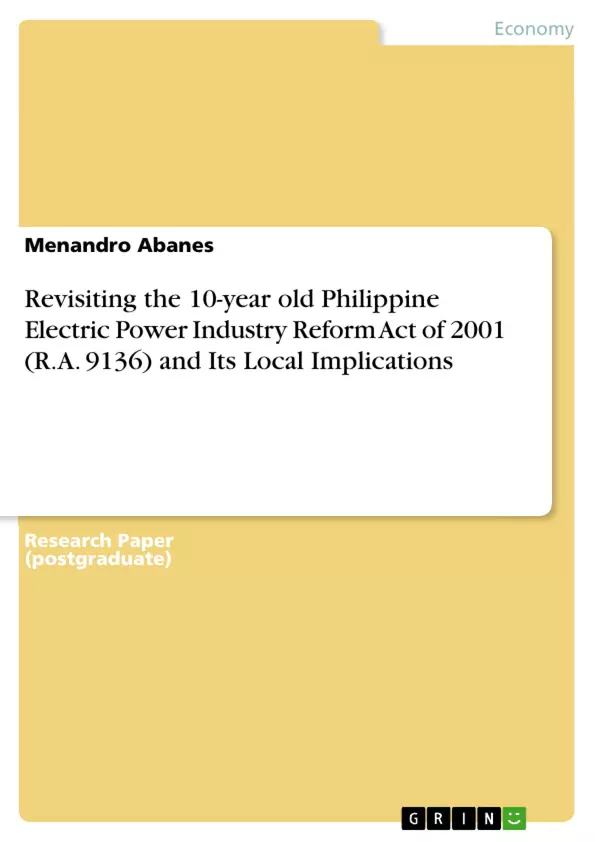After 10 years of implementation of the Electric Power Industry Reform Act of 2001 (Republic Act 9136), there is so much to be desired from its promised and potential reforms and improvements in the power industry and the lives of consumers.
The privatization effort of the National Power Corporation (NPC) and its massive debts continues. The electricity rate used and paid by millions of consumers keeps rising. The mismanagement of electric cooperatives and their inexplicable losses persists.
This is to revisit the law that sought, among others, to; 1) privatize the government agency tasked to generate, transmit, distribute, and supply energy to the country, 2) unbundle the power sectors to identify which is inefficient and incurring losses, 3) create a Wholesale Electricity Spot Market (WESM) to make the transaction transparent, open and competitive, 4) reduce the power rates.
In June 2011, the Philippine President, Benigno Aquino III, signed into law the extension of the implementation of lifeline electricity rate (subsidy) for poor consumers for another 10 years. The wisdom of the R.A. 9136 was that the lifeline rate would be unnecessary after 10 years of the Act because the electricity rate would have been affordable even by poor consumers.
On the contrary, after 10 years of R.A. 9136, the Philippines has the highest power rate in Asia. Thus, it is important to review the law in light of the current situation, context and its history.
Inhaltsverzeichnis (Table of Contents)
- Introduction
- History of R.A. 9136
- An Impending Power Crisis
- NPC's Swelling Debt
- Government's Alternative
- Overview of R.A. 9136
Zielsetzung und Themenschwerpunkte (Objectives and Key Themes)
This paper revisits the Electric Power Industry Reform Act of 2001 (R.A. 9136) ten years after its implementation, evaluating its intended reforms and their actual impact on the Philippine power industry and consumers. It examines the challenges faced in privatizing the National Power Corporation (NPC) and its debt burden, the increasing electricity rates, and the persistent mismanagement of electric cooperatives. The paper analyzes the historical context of the law and its objectives, including the creation of a competitive market through the Wholesale Electricity Spot Market (WESM). It also explores the global trend of privatization and restructuring in the power sector and compares the Philippine experience to other countries.
- Privatization of the Philippine power industry
- Impacts of R.A. 9136 on electricity rates and affordability
- Challenges in managing the National Power Corporation (NPC) and its debt
- Performance and management of electric cooperatives
- The role of the Wholesale Electricity Spot Market (WESM) in fostering competition
Zusammenfassung der Kapitel (Chapter Summaries)
- Introduction: This chapter introduces the paper's purpose, which is to revisit the Electric Power Industry Reform Act of 2001 (R.A. 9136) and assess its impact on the Philippine power industry and consumers. It highlights the continued challenges in privatizing the National Power Corporation (NPC), rising electricity rates, and the ongoing mismanagement of electric cooperatives.
- History of R.A. 9136: This chapter details the legislative process that led to the enactment of R.A. 9136, including the debates, lobbies, and consultations that took place over seven years. It discusses the factors that led to the law's passage, particularly the looming power crisis and the growing debt of the National Power Corporation (NPC).
- An Impending Power Crisis: This chapter explores the growing demand for electricity in the Philippines and the government's need for additional power generation capacity. It discusses the budget constraints faced by the government and the financial difficulties of the NPC, which led to the consideration of privatization as a solution.
- NPC's Swelling Debt: This chapter examines the significant debt burden of the NPC, which was nearly half of the government's total debt. It describes the various factors contributing to the NPC's debt, including contracts with Independent Power Producers (IPPs) and the depreciation of the Philippine peso.
- Government's Alternative: This chapter presents the government's rationale for privatizing the power industry as a solution to the looming power crisis and the NPC's financial difficulties. It argues that privatization would attract private sector investment, allowing the government to redirect funds to other priorities.
Schlüsselwörter (Keywords)
The key terms and concepts discussed in this paper include the Philippine power industry, R.A. 9136, privatization, National Power Corporation (NPC), Wholesale Electricity Spot Market (WESM), electricity rates, electric cooperatives, Independent Power Producers (IPPs), and the Energy Regulatory Commission (ERC). This paper analyzes the impact of the Electric Power Industry Reform Act of 2001 on the structure and performance of the Philippine power sector and its implications for consumers.
- Arbeit zitieren
- Menandro Abanes (Autor:in), 2011, Revisiting the 10-year old Philippine Electric Power Industry Reform Act of 2001 (R.A. 9136) and Its Local Implications, München, GRIN Verlag, https://www.grin.com/document/176845



